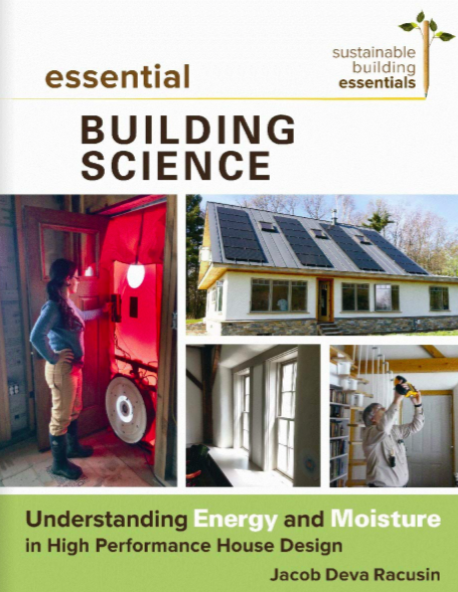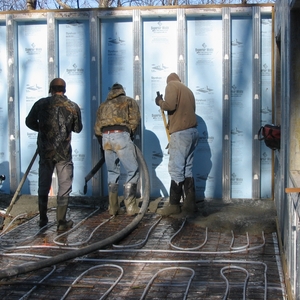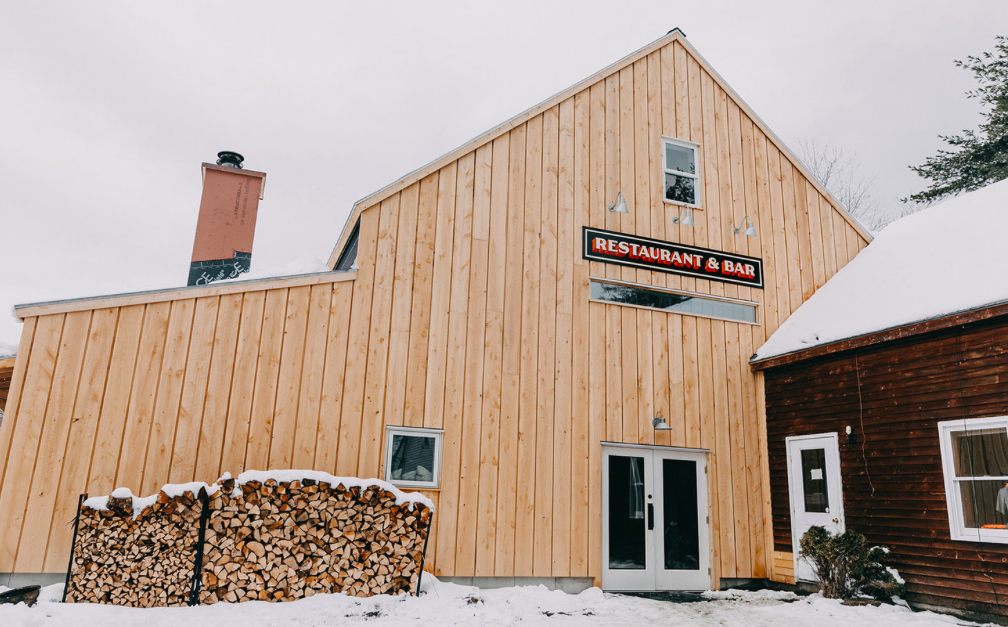
This episode of the BS* + Beer show features Albie Barden, John Siegenthaler, and Patrick McCombe discussing the topic “Heating With Wood.” The conversation revolves around making the most efficient use of wood as a fuel source. Albie makes a solid case for masonry heaters as the cleanest and healthiest form of wood heat. He explains how they function, why they provide stable temperatures, and their DIY appeal. John shares his deep expertise as a mechanical engineer purporting the science and application of modern hydronic heating systems. He stresses the importance of thermal storage (which he describes as a BTU battery), explains the idea of “batch-burn cycles,” and highlights the flexibility of the hydronic system to feed multiple appliance loads. Patrick represents the tried-and-true approach. He shares his experience of heating his barn-turned-office with a 1930s cast-iron wood stove, which he fuels with wood from felled trees on his property that he has bucked and split himself. Cost considerations, temperature control, particulate matter, load zones, and makeup air are among the issues discussed. Because our guests bring to the table such varying approaches to wood heating, this episode has broad appeal.
Enjoy the show!
Join us on Thursday, January 28, from 6 to 7:30 p.m. EST for a conversation with lighting expert David Warfel, author of Fine Homebuilding’s “Lighting for the Long Term” and “The Lighting Power of LEDs” and Jeff Calkins, owner of Calkins Electric Supply Co. We will talk about energy-efficient lighting options, design strategies and best practices, and how lighting affects occupant health.
Use this link to register for The BS* + Beer Show
Speaker bios
David Warfel is founding designer of Light Can Help You (LCHY), an author, and an educator. He serves as lighting advisor to the ProSource buying group, is leading the development of the first integrator-specific lighting certification program, and is former head of the graduate lighting design program at the University of Illinois. David’s company built their Signature Custom Lighting Design service to be an easy, affordable, and professional option for lighting design. The LCHY team partners with custom integrators nationwide to help them grow lighting fixture sales and navigate the complex and rapidly changing world of light. David’s design credits range from projects at Carnegie Hall and Las Vegas’s Luxor to Chicago’s Hyde Park Arts Center, and multiple themed spaces for Royal Caribbean Cruise Lines. While he and his team still design commercial projects, their primary focus is on custom residential projects from coast to coast (and beyond). His work and writing have been featured in Technology Design, Fine Homebuilding, Lighting Australia, and Houzz.com. David blogs at Language of Light and lives in Madison, WI.
Jeff Calkins studied architectural engineering, mathematics, and psychology at the University of Kansas. In 1991, he began working full time for the family business, Calkins Electric Supply, in downtown Shawnee, Kansas, which was started by his grandfather in 1957. He, his sister, and his son now run the company. Of all aspects of the electrical industry, Jeff has always enjoyed lighting and lighting design the most. He has been part of some gratifying lighting installations that include the Johnson County Arts & Heritage Center’s “All Electric” house exhibit. Recently, he and his brother purchased and renovated the historic Aztec Theater—also in downtown Shawnee—which recently re-opened for business.
BS* + Beer Book Club
Because the hosts of the BS* + Beer Show all love to read, we thought we would celebrate the authors in our industry by adding a book club to the show every few months. We’ll announce the book, give you a few months to get it and read it, and conclude with a BS* + Beer Show episode where we will invite the author to join us, present, and take questions.

We have selected our third book: Essential Building Science: Understanding Energy and Moisture in High Performance House Design by Jacob Deva Racusin.
We hope you will pick up a copy and join the discussion on April 1st.
________________________________________________________________________
You can contact Kiley Jacques at [email protected]. Main photo courtesy of Patrick McCombe.
Weekly Newsletter
Get building science and energy efficiency advice, plus special offers, in your inbox.















3 Comments
People joining the book club discussion might want to check the review and list of errata at https://www.greenbuildingadvisor.com/article/building-science-information-for-builders
I haven't read Jacob's book yet but I had read Martin's review. Having seen Jacob speak at conferences and seminars, and talking with him on several occasions in person, I know he is an absolute wealth of knowledge, with a different perspective than most. I also have a lot of respect for Martin's experience and opinions. Both of them have been significant influences on my career, and having drinks at pubs with both of them (separately) contributed to the idea of BS + Beer.
Anyway, getting off topic--definitely read Martin's review, but don't skip Jacob's defense in the comments. Better yet, read the book for yourself and tune in to The BS + Beer Show to let us know what you thought!
As a foll0w-up to the Heating With Wood episode, Albie sent this email, with permission to share here:
Thanks to you and your team for inviting me to participate in one of your Zoom seminars/discussions. As I mentioned online, I am happy to receive requests for information about masonry heaters from any of your network and happy as well to send out free pdfs of several of the manuals I have written so that people can get a clearer idea of what masonry heaters are all about. Many people with an interest in wood heating will know nothing about masonry heaters so there is always a learning curve to follow as well as a clearer understanding of all aspects of wood handling and storage and clean burning.
Kiley's questions about controlling heat were very pertinent especially as we talk of smaller tighter houses all the way down to tiny houses. The little one tile heater/cooker that I designed is a good DIY project and capable of heating and cooking in either a tiny house or a small cabin. We are about to take one this Spring up to the oldest cabins on Ambajejus Lake in Millinocket, Maine and install it in the restored "Boathouse" cabin which is literally right on the water's edge grandfathered from the mid 1880's. The Boathouse is about eighteen feet by fourteen feet and would have originally had a non-airtight metal or asbestos shielded cast iron stove tucked in a corner with a single wall stove pipe going through a tin panel in the ceiling and another tin panel in the roof. It would have been heating "feast or famine" with such a stove either being too hot or too cold. With the Flue tile heater and its seven inch thick wall, we can top load it and get immediate heat off the cook surface to cook a meal and start to warm the space up. With a fire going an hour or two, the whole mass gets warm and holds a gentle even heat overnight in a well-insulated space. Because the wall thickness is so great, the surface temps on the outer side faces of the heater are modest and safe to within four inches of a combustible wall making such a unit much safer near a wall than the original metal stove that would have been there. We will go with double wall pipe to the ceiling and then Class A chimney through the loft and the roof. We will carry the unit across the lake on a converted old pontoon boat now equipped to be a barge to the cabins. It is dry stacked and banded together now so we will take it off in pieces and restack it in the cabin with refractory mortar used only as a thin layer between the firebrick courses of the lining/firebox.
In the main cabin which is larger, we have a classic lumber camp "biscuit gun" (with doors on both sides for easy loading of large volumes of baked goods in and out of the oven) lower to the floor (to accommodate massive cast iron pots of soup etc.) large cast iron Noyes and Nutter Ironside cookstove which cooks and bakes and heats the cabin. Because this larger cabin is not insulated, it is never too much heat.
A young friend of mine built a lovely tiny house on a recycled double axle trailer body and could not figure out how to best heat it with wood. She finally found one of the elegant looking firebrick lined enameled steel cylinder stoves with cast iron base and top made by the French Company Godin. This was designed and built as a coal stove but the larger Godin model was sometimes purchased in the '70's as a top loading cord wood stove because it could take some normal wood splits which Mainers are accustomed to using. The round footprint of the stove was only about 14 inches in diameter I think so it took up very little room. its thick walls made it safer to put close to a wall and it was very handsome to look at. She found it online at a price well below its original retail cost. I have seen a few other pieces of this stove advertised online but it is rarely next door and usually too heavy and too awkward to crate and easily ship.
The beautiful Tigchelehaters from Holland are some of my favorite little heaters from a design and function point of view. They have a small firebox, however, but can also be assembled by a homeowner and have no mortar in their tongue and groove gasketed joints throughout. They are made of cast refractory concrete but are made in molds which leave a lovely polished finish on the material and mortar colors are added to the mix to make them some of the most beautiful little kits heaters that I know of. I have only brought in a couple of these heaters over the years. They are expensive to purchase and to ship and the owner must be prepared to use smaller wood and only need a small heater. I travelled twice to Holland to see these beautiful heaters and to befriend the family that makes them. If I lived in Holland, I am sure that I would use one or two of them in my home.
I am also impressed by the Ironheart Cookstove heater by Esse from England. The stove is appropriate for a cabin or smaller space with a large fire viewing firebox, insulated sides, a good oven and big insulated lids to come down over the very large quick response hot plates. Sometimes an all in one cooker/heater like this can work very well for a wood burning aficionado looking to find the perfect stove for a smaller space. There are good online videos of the Ironheart.
There is a company in Finland that makes a wide range of completely precut brick and tile and firebrick and cast refractory components heaters so that the pallet(s) arrive with everything ready to assemble with no cutting and no waste. This is the company Tiileri (meaning Bricks in Finnish.) When I was with Maine Wood Heat we brought in a few of these one at a time but overseas shipping one at a time took a while from order to delivery and freight costs were high because they were not being shipped in volume. I liked the owners very much and met with them twice at the annual Masonry Heater Association retreat in North Carolina.
My favorite American made wood stoves are the soapstone and cast iron stoves made in Lebanon, NH by Woodstock Soapstone Stove Company. They are beautiful and very clean burning combining both secondary combustion (heated air introduced over the fire) as well as a catalytic combustion plate in the upper part of the stove. These stoves are sold factory direct with no dealer network and a six month money back guarantee.
Thanks for the inquiry about my portable bathtub oven. It was so much fun to design and build it and then find out how versatile and reliable it was to use in our back yard or to carry to events or friends near and far away.
Warmest regards to all on your team,
albie barden
Log in or create an account to post a comment.
Sign up Log in